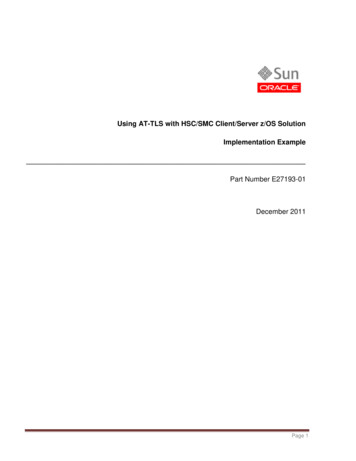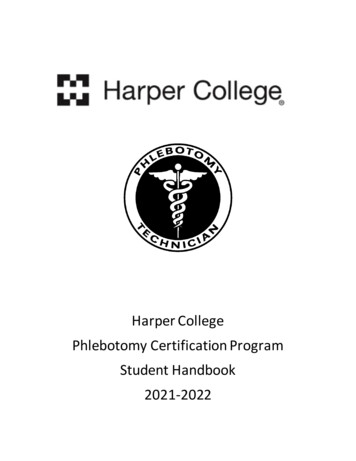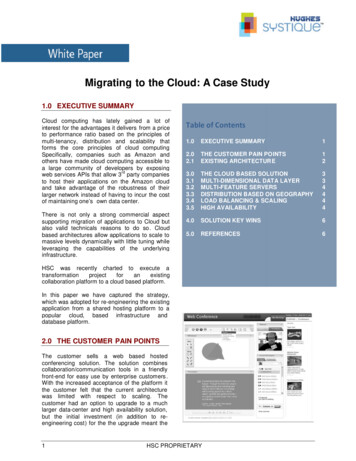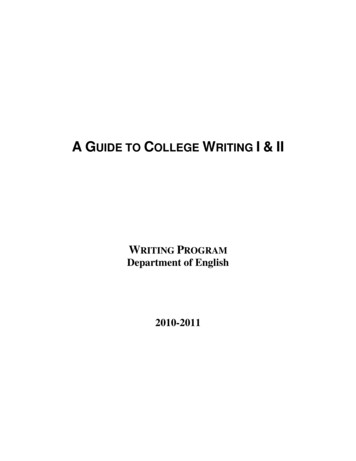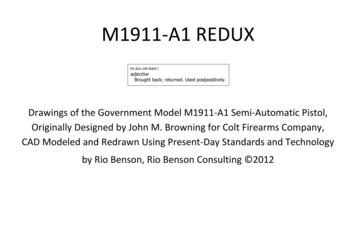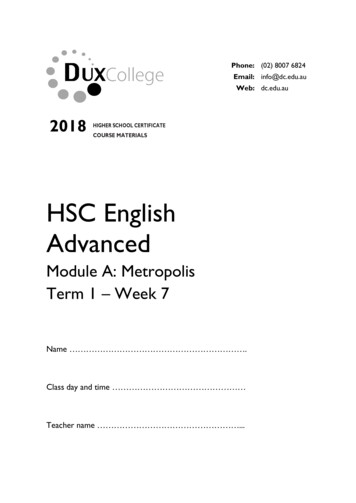
Transcription
DUX2018Phone: (02) 8007 6824Email: info@dc.edu.auWeb: dc.edu.auHIGHER SCHOOL CERTIFICATECOURSE MATERIALSHSC EnglishAdvancedModule A: MetropolisTerm 1 – Week 7Name .Class day and time Teacher name .
HSC English Advanced - Module A: MetropolisTerm 1 – Week 7DUX1Term 1 – Week 7 – Theory Film AnalysisHomeworkFILM ANALYSISSEGMENT SIX (THE MACHINE-MAN)After discovering the workers' clandestine meeting, Freder's controlling, glacial father conspires withmad scientist Rotwang to create an evil, robotic Maria duplicate, in order to manipulate his workers andpreach riot and rebellion. Fredersen could then use force against his rebellious workers that would beinterpreted as justified, causing their self-destruction and elimination. Ultimately, robots would becapable of replacing the human worker, but for the time being, the robot would first put a stop to theirrevolutionary activities led by the good Maria: "Rotwang, give the Machine-Man the likeness of that girl. Ishall sow discord between them and her! I shall destroy their belief in this woman --!" After JohFredersen leaves to return above ground, Rotwang predicts doom for Joh's son, knowing that he will bethe workers' mediator against his own father: "You fool! Now you will lose the one remaining thing youhave from Hel - your son!" Rotwang comes out of hiding, and confronts Maria, who is now alone deep inthe catacombs (with open graves and skeletal remains surrounding her). He pursues her - in theexpressionistic scene, he chases her with the beam of light from his bright flashlight, then corners her,and captures her when she cannot escape at a dead-end.The next day, Freder vainly searches for Maria in the cathedral. He listens as a monk in the pulpitpreaches:Verily I say unto you, the days spoken of in the Apocalypse are nigh!.(The monk quotes from the Bible)And I saw a woman sit upon a scarlet-colored beast, full of names of blasphemy, having seven headsand ten thorns. And the woman was arrayed in purple and scarlet color, having a golden cup in her hand.And upon her forehead was a name written, mystery, Babylon the Great, the mother of abominations ofthe earth.Freder then addresses a life-sized statue of the Grim Reaper in a display of seven statues representingthe Seven Deadly Sins: "If you had come earlier, you wouldn't have scared me. But now I beg you: Stayaway from me and my beloved!"Later, Freder tells Josaphat that he will continue to look for Maria: "I must go. I must look on my own forthe person to whom 11811 was supposed to lead me."In Rotwang's laboratory, the Machine-Man sits, looking like an Egyptian deity. Light streams from above.Rotwang takes its hands and speaks to it, revealing his ultimate diabolical plan to displace Fredersen asMaster and to take power himself:You will destroy Joh Fredersen - him and his city and his son. Dux College 2018 All rights reserved.Need help?Visit the student forums and ask our tutors.dc.edu.au/forumsT: (02) 8007 6824E: info@dc.edu.auW: dc.edu.au
HSC English Advanced - Module A: MetropolisTerm 1 – Week 7DUX2Then Rotwang threatens the kidnapped Maria, stalking her and announcing his intentions: "Come! It istime to give the Machine-Man your face!" As he bends her over a table, she screams out - and her criesfor help through a grating in the ceiling are heard by Freder, who happens to be walking by in the street.Freder attempts to save her (and enters Rotwang's residence, but is trapped inside by doors that openand close on their own), but her pleas are muffled by Rotwang, and she is taken deeper into hislaboratory. He calls out for Maria, knowing she is there after finding her scarf, but he cannot locate her.In the film's most celebrated creation-transformation scene set in Rotwang's laboratory, the madscientist has attached Maria (lying horizontally in a cylindrical clear chamber/capsule) by wiredconnections and a helmet to the Machine-Man. His laboratory is filled with bubbling beakers of liquid,dials, switches, flashing electrical circuits and arcs, and other contraptions. When he turns a switch,lightning sparks of energy descend from a round ball in the ceiling to the head and foot of the cylinder.Luminous, glowing rings surround and move vertically atop the standing robot, as its circulatory system isenergized with Maria's life force, and Maria's face dissolves into the face of the android. The real Marialoses consciousness as the robot likeness becomes flesh and blood.According to Andreas Huyssen in The Vamp and the Machine: Technology and Sexuality in Fritz Lang'sMetropolis: The doubling of Maria, the use of religious symbolism, the embodiment of technology in awoman-robot and Freder's complex relationship to women and machines, sexuality andtechnology, gives us a key to the film's social andideological imaginary.Neue SachlichkeitHistorically and stylistically Lang's Metropolis, whichwas conceived in 1924 during a visit to the UnitedThe New Objectivity (in German NeueSachlichkeit) is a term used toStates (including New York) and released in Januarycharacterise the attitude of public life1927, is a syncretist mixture of expressionism andin Weimar Germany as well as the art,Neue Sachlichkeit, and, more significantly, aliterature, music, and architecturesyncretist mixture of the two diametrically opposedcreated to adapt to it. Rather than theviews of technology we can ascribe to these twogoal of philosophical objectivity, it wasmovements. More precisely, the film works throughmeant to imply a turn towardsthis conflict and tries to resolve it. Ultimately thepractical engagement with thefilm, even though it pretends to hold on to theworld—an all-business attitude,humanitarian anti-technological ethos ofunderstood by Germans as intrinsicallyexpressionism, comes down on the side of NeueAmerican: “The Neue Sachlichkeit isSachlichkeit, and the machine vamp plays the crucialAmericanism, cult of the objective, therole in resolving a seemingly irreconcilablehard fact, the predilection forcontradiction.functional work, professionalconscientiousness, and usefulness”. Dux College 2018 All rights reserved.Need help?Visit the student forums and ask our tutors.dc.edu.au/forumsT: (02) 8007 6824E: info@dc.edu.auW: dc.edu.au
HSC English Advanced - Module A: MetropolisTerm 1 – Week 7DUX3 For his indictment of modern technology as oppressive and destructive, which prevails in most ofthe narrative tradition, the context of the film makes it clear that in every respect, it is maledomination and control which are at stake: control of the real Maria who represents a threat tothe world of high technology and its system of psychic and sexual repression; domination of thewoman-robot by Rotwang who orders his creature to perform certain tasks; control of the laborprocess by the Master of Metropolis who plans to replace inherently uncontrollable living laborby robots; and, finally, control of the workers' actions through Frederson's cunning use of themachine-woman, the false Maria. On this plane, then, the film suggests a simple and deeply problematic homology betweenwoman and technology, a homology which results from male projections: Just as man inventsand constructs technological artifacts which are to serve him and fulfill his desires, so woman,as she has been socially invented and constructed by man, is expected to reflect man's needsand to serve her master. Furthermore, just as the technological artifact is considered to be thequasi-natural extension of man's natural abilities (the lever replacing muscle power, thecomputer expanding brain power), so woman, in male perspective, is considered to be thenatural vessel of man's reproductive capacity, a mere bodily extension of the male's procreativepowers. But neither technology nor woman can ever be seen as solely a natural extension ofman's abilities. They are always also qualitatively different and thus threatening in theirotherness. It is this threat of otherness which causes male anxiety and reinforces the urge tocontrol and dominate that which is other (this post-war anxiety is consistent with the need toredeem and restore a damaged masculinity in the wake of Germany’s World War One defeat)According to feminist film critic Gabriela Stoicea in Re-Producing the Class and Gender Divide: Maria a serious threat to paternal authority and to the social divide between the rich and thepoor, it then makes sense for the capitalist ruler to produce a uni-dimensional robot-likeprototype-the incarnation of "pure" female sexuality cleansed of all maternal feelings.According to critic R. L. Rutsky in The Mediation of Technology and Gender: The black, mechanical form of Rotwang's female robot - its form is feminine even before its birth,or rebirth, in the figure of Maria - serves to replace his lost love Hel, just as his black prosthetichand replaces his lost one. Unlike Fredersen, whose possession of the woman/ mother takesplace under the imprimatur of a paternal, phallic law, Rotwang must piece together asimulated, mechanical copy, onto which he will conjure the shape, and the inverted spirit, of thewoman/mother. Rotwang, in other words, invests this technological replacement not only withan electrical, but with an emotional/spiritual charge. The technological object-itself becomesdefined by its reproducibility, by its status as a substitute. Dux College 2018 All rights reserved.Need help?Visit the student forums and ask our tutors.dc.edu.au/forumsT: (02) 8007 6824E: info@dc.edu.auW: dc.edu.au
HSC English Advanced - Module A: MetropolisTerm 1 – Week 7DUX4Motif of Doubles/Dopplegangers Maria and her double, the virgin and the whore have been much discussed over the years. Ascritics have pointed out, collapsed into the figure of Maria herself are at least two distinct Biblicalfigures: John the Baptist (she preaches the coming of the saviour) and the Virgin Mary (she isboth a virgin and a mother figure) One could add a third: on her first appearance, surrounded bychildren, Maria evokes sentimental religious paintings of Christ as Matthew 19:14 'suffer littlechildren to come unto me’ adds to these contradictory associations the figure of the persecutedheroine. All these associations go back to the novel, which is saturated with Christian allusionsand motifs.According to film critic Anton Kaes in “Metropolis: City, Cinema, Modernity”: The split of Maria into an asexual “good” Maria and an oversexed “bad” Maria may also be areaction to the emergence of emancipated and sexually liberated women as well as organisedfeminist activity in the mid- 1920s. The robot Maria, as the “new woman,” rips the social fabricasunder, inciting the workers to rebel and seducing them into self-destructive acts.What perspectives on technology are represented in the ‘Machine-Man’ segment?How does technology come to embody male fears of a newly liberated and sexually autonomouswoman of 1920s German society? Dux College 2018 All rights reserved.Need help?Visit the student forums and ask our tutors.dc.edu.au/forumsT: (02) 8007 6824E: info@dc.edu.auW: dc.edu.au
HSC English Advanced - Module A: MetropolisTerm 1 – Week 7DUX5SEGMENT SEVEN (THE YOSHIWARA CLUB AND FALSE MARIA IN THE CATACOMBS)In the next scene, the evil False Maria, portrayed with her left eye drooping slightly shut, is in the officeof Master Fredersen - he orders her to initiate his plan:I want you to visit those in the depths, in order to destroy the work of the woman in whose image youwere created!Freder rushes in, completely disoriented (the camera image rotates and flashes) to find Maria in thearms of his father, and he collapses, falling dangerously ill. On his sick bed, the feverish, delirious Fredernotices an invitation given to his father from Rotwang - who "requests the pleasure of your company atdinner and to see a new Erotic Dancer." A group of wealthy, tuxedoed men, including Joh Fredersen andRotwang, watch as the false Maria rises on a stage platform in the depraved nightclub, and begins herlascivious performance of an almost-nude, hip-swiveling Salome-style dance. The lustful men in theaudience watch in amazement - their lecherous, fixated eyeballs seen in a montage. The erotic dancer isportrayed as the one that the cathedral monk had spoken of, the whore of Babylon riding on a beastwith seven heads. "For her - all seven deadly sins!" The distraught Freder imagines, in a hallucination,that the Grim Reaper statue comes to life, playing a leg bone like a flute during her dance. In his vision,the Reaper swings his sharp scythe and cries out: "Death descends upon the city -- !"The false Maria's dancing incites men, lured to her treachery and seductiveness at Yoshiwara's, tobecome angry and aggressive toward each other. Freder cannot believe what he hears, that Maria ishaving a dangerous effect on the city: "And this woman, at whose feet all sins are heaped is also namedMaria." Freder asks: "The same woman who those in the depths look up to as a saint --?!" Freder remindsJosaphat: "Many now go to the city of the dead, to a woman who has proven herself as true as gold.Butthe mediator must appear!"The Thin Man reports to Fredersen in his office: "Only their hope for a mediator is keeping the workers incheck." "Whatever happens tonight," Fredersen instructs the Thin Man in his office, "it is my expressorder to let the workers do as they will." Meanwhile, Rotwang holds the real Maria captive, telling herabout Fredersen's ultimate plan to stir up rebellion among the workers, to have them abandon theirmachines, and then quell the workers with brutal force:Joh Fredersen wants to let those in the depths use force and do wrong, so that he can claim the right touse force against them.When you spoke to your poor brothers, you spoke of peace, Maria.Today, amouthpiece of Joh Fredersen is inciting them to rebel against him.Maria is devastated by news of the false Maria: "She will destroy their belief in a mediator!" But thenRotwang informs her of his own double-cross: ".but I have tricked Joh Fredersen! Your double does notobey his will - only mine!" In the attic with Maria, Rotwang grows ever more intoxicated by his triumphover Fredersen: "And I tricked Fredersen twice over -! For I concealed from him that his son wants to beyour brothers' mediator - and loves you -!". Dux College 2018 All rights reserved.Need help?Visit the student forums and ask our tutors.dc.edu.au/forumsT: (02) 8007 6824E: info@dc.edu.auW: dc.edu.au
HSC English Advanced - Module A: MetropolisTerm 1 – Week 7DUX6At the same time, on the altar in the catacombs, the false and fanatical robotic Maria preaches a newmessage of protest and violent revolt to entice and agitate the working class to rebel:You know that I have always spoken of peace.but your mediator has not come.You have waited longenough! Your time has come -! Who is the living food for the machines in Metropolis -!? Who lubricatesthe machine joints with their own blood -?! Who feeds the machines with their own flesh --?! Let themachines starve, you fools- ! Let them die -!! Kill them - the machines -!!Freder and Josaphat proceed down into the catacombs where they find the false Maria preachingdissension, and aghast, Freder cries out twice: "You are not Maria -!!! YOU ARE NOT MARIA -! Mariaspeaks of peace, not killing -! This is not Maria -!!" One of the workers recognises Freder, and denounceshim as the Master's son -- "Kill him, the dog,in his white silken fur - !!!" With his bare fists,Freder bravely fights off an assault of theworkers, resulting in one of them beingfatally stabbed. Another worker shouts outfor them to abandon the undergroundworkers' city: "Get your women, your sons,from the workers' city! Let no one staybehind! Death to the machines -!!!" After theworkers march away en masse, as aferocious, club-wielding mob, to destroy themachines in the Underground City, Josaphatand Freder attend to the wounded worker,who recognises that Freder is truly "faithfulafter all" - before he dies.According to critic Michael Cowan in The Heart Machine: “Rhythm” and Body in Weimar Film and FritzLang’s Metropolis: Rotwang’s experiment, by infusing the robot with the life-force of organic rhythm, transformswhat was an obedient machine—Rotwang’s Maschinenmensch—into an agent of uncontrollablesexual chaos. In this sense, Rotwang also creates a precise counterpart to the controlling “heartmachine” at the center of Fredersen’s industrial city.False Maria also institutes an alternative rhythmical spectacle with her famous erotic dance atYoshiwara’s. In a scene reminiscent of Claire Lescot’s sexualized soirées in L’Inhumaine, Mariaarrives atop a giant pedestal held up by a circle of nearly-nude black male figures bearingprimitivist tribal attire.Maria’s subsequent Josephine-Baker-style dance—which Lang’s editing stages as an everaccelerating rhythmical frenzy—will then send her male audience into convulsions, causingthem to lose all self-control and attack one another before the stage.In terms of its effects upon its audience, Maria’s erotic spectacle recalls the belief, widespreadin the early 20th century, that violent or erotic representations in the cinema could provoke anatavistic regression in spectators. Through editing, close-ups and superimposition, Langgradually reduces Maria’s spectators to a collage of lustful eyes. Through this emphasis on thestaring eyes, Lang presents the male audience here not so much as voyeuristic— in the sense ofa distanced, controlling gaze—but rather as mesmerised, Maria’s rhythmical spectacle causingthem to lose all self-control. Dux College 2018 All rights reserved.Need help?Visit the student forums and ask our tutors.dc.edu.au/forumsT: (02) 8007 6824E: info@dc.edu.auW: dc.edu.au
HSC English Advanced - Module A: MetropolisTerm 1 – Week 7DUX7According to Andrew Webber in Fritz Lang's Metropolis: Cinematic Visions of Technology and Fear: The extraordinary montage of lustfulkaleidoscopic eyes that gaze at Mariapresents a spectacle of male desire asfixated, in every sense, at the phallicstage.The montage of eyes can thus beunderstood as reproducing theuncanny effects of technologicalproliferation, of the organic becomingartificialThe profusion of eyes in these cut-upvisual effects would thus appear to matchthe classic form of the Freudian uncanny:the compulsively repetitiverepresentation of the primal lack which is male castration.According to Joséphine A. Zmolek in Metropolis: A Vision of Power, Body and Myth: In Freder’s second hallucination, he seesthe false Maria, Futura, in her luridSalomé dance at Rotwang’s house. Heimagines the Whore of Babylon, ridingthe beast of seven heads and ten horns:The woman dressed in purple and scarlet,and glittered with gold and jewels andpearls, and she was holding a gold winecup filled with the disgusting filth of herfornication; on her forehead was writtena name, a cryptic name; “Babylon theGreat, mother of all the prostitutes andall the filthy practices on the earth.” (Rev:17:4-6, The Jerusalem Bible)Jensen views the polar Marias as epitomising “the division between the free rulers and themachine-like workers they control”, contrasting humanity and the antagonist machine.Springer argues that False Maria represents the male fear of women and of machines. Springerprovides: “Industrial-age machine bodies tended to be associated with phallic power whetherthey were pumped up male superheroes or aggressive phallic women like the robot Maria. 19thand early 20th century patriarchy used the machine metaphor to fortify its sense of power; themachine as phallus declared men’s invincible dominance over women”. Dux College 2018 All rights reserved.Need help?Visit the student forums and ask our tutors.dc.edu.au/forumsT: (02) 8007 6824E: info@dc.edu.auW: dc.edu.au
HSC English Advanced - Module A: MetropolisTerm 1 – Week 7DUX8SEGMENT EIGHT (WORKER REBELLION)Joh Fredersen breaks into Rotwang's attic. He battles with his old rival, overcoming him. Maria is free.She races to the city's town square where the workers and their families have assembled under thedirection of the false Maria. She rallies them and urges them to follow her: "Women and men, let no onemiss today -! Death to the machines -!!" She leads them to the elevators that take them to the machines.One woman declares there is total support for the worker revolution: "Not one man - or womanremained behind -!" - although the children have not been evacuated. After ripping through outer irongates, the mob storms the M-Machine and rushes toward the Heart Machine, the power house ofMetropolis. Grot closes the gate and tries to notify Fredersen. Using an advanced videophonecommunications system, Joh Fredersen speaks with chief foreman Grot and learns of the impendingcrisis. He sternly orders: "Open the gates!" Grot warns Fredersen that if the Heart Machine is destroyed,it would shut down energy for the city: "If the Heart Machine is destroyed, the entire machine district willend up in ruins." Finally, Grot obeys Joh Fredersen's order and opens the gates. The workers race to theHeart Machine, and confront Grot who stands alone to defend the machine:Have you gone mad - ? If the Heart Machine is destroyed, the entire workers' city will be flooded -!!But his warnings are ignored and he is overwhelmed. The false Maria causes the Heart Machine tooverheat and short-circuit until it disintegrates, causing the pumps to stop turning which then produces acataclysmic flood. After running from Rotwang's home, the real Maria comes upon the workers' citywhere she witnesses the failure of the machines. Water ruptures through the street and begins to floodthe Underground City - the workers' quarters. She sounds the alarm in the transit, town-square area ofthe city with the giant gong and gathers some of the worker children together there to rescue them fromthe rising waters. The children clamor for high ground with arms outstretched, to be evacuated to safety.The exploding Heart Machine and M-Machine cause the lights of the city to extinguish, witnessed byJoh Fredersen who now sits in his darkened high-rise office. The Thin Man informs the shockedFredersen: "Do you know that your son is among the workers?" He asks: "I must know! Where is myson?!!!" The Thin Man replies: "Tomorrow, thousands will ask in fury and desperation: Joh Fredersen,where is my son -!", but Fredersen refuses to listen.Grot finally gets the attention of the workers, who joyously and obliviously celebrate the machines'destruction by dancing in a large circle. He reprimands them for their senseless, irresponsible actionswhich brought about the destruction of their children:Where are your children?! The city lies underwater, the shafts are completely flooded -!! Who told youto attack the machines, you idiots? Without them you'll all die!!"They scream back an answer: "It's the witch's fault -!" He responds: "Find the witch, this is all her fault -!Strike her dead -!!" and leads them on a witch-hunt rampage to find "the witch."Back at Yoshiwara's, the false Maria celebrates and dances with the tuxedoed men, urging them: "Let's allwatch as the world goes to the devil!". Dux College 2018 All rights reserved.Need help?Visit the student forums and ask our tutors.dc.edu.au/forumsT: (02) 8007 6824E: info@dc.edu.auW: dc.edu.au
HSC English Advanced - Module A: MetropolisTerm 1 – Week 7DUX9According to feminist film critic Gabriela Stoicea in Re-Producing the Class and Gender Divide: The return to a repressed femininity had been announced from the very beginning of therebellion by a musical reference to the French Revolution, in which thousands of women foughtbut were similarly excluded from politics by the end of the insurgency.In the sequence where the false Maria rallies all the adult inhabitants of the workers' city on thecentral plaza, a shot of the female cyborg moving her head convulsively accompanies anacoustic reworking of the Marseillaise. The same musical score continues in the next shot, inwhich two women run out of the tenements toward the camera. By the end of the film,however, no women remain in the crowd. The renewed invisibility of workers' wives in the finalshot of Metropolis suggests that motherhood has first been demonized, then put in its properplace along with hedonistic female sexuality, as male workers' patriarchal interests arereactivated. If the upper and the lower classes cannot unite to pursue a common political goal,they can still co-exist peacefully in the face of a common threat, namely woman, with all herexcesses.According to critic Michael Cowan in The Heart Machine: “Rhythm” and Body in Weimar Film and FritzLang’s Metropolis: Harbou’s novel’s obsessive preoccupation with stoneand vital waters provided the groundwork for thefamous flood sequence in the film version ofMetropolis.The film recalls Harbou’s allegory of the spring (asymbol of the lush growth of springtime andfecundity) in the many images of water smashingthrough the geometric stone buildings of theunderground city. But while the film retains Harbou’scritique of rationality, it largely plays down the positive connotations of the flood to present theunleashing of vital forces more specifically as a source of danger. Like the novel, the film draws adirect parallel between the images of flooding water and the movement of the revolting workers asthey tear down every barrier on their unstoppable flow toward the machine rooms.This formless flowing mass is, of course, unmistakably coded as feminine, marked as it is by thepresence of the workers’ wives, who appear in this scene for the first time in the film. If thischaracterization of the masses as a feminine flood recalls the paranoid male fantasies investigated byKlaus Theweleit, it also recalls the understanding of primal rhythm by reformers like Bode, whochampioned the rhythms of nature as a feminine, liquid element opposed to the masculine activityof rational segmentation.The cinema of rhythmic contagion (reflected in False Maria’s erotic dance in the Yoshiwara club)stands diametrically opposed to the heart machine, and it must be brought under control at the endof the film. As Siegfried Kracauer recognised, this exorcism occurs not only through the burning of thebad Maria, but also through the re-ordering of the mass flood into a perfectly geometric massornament. The crowd’s unified and disciplined movement in the final handshake scene seems tosuggest that the “heart machine”—mediating between the body and the intellect, nature andtechnology—has once again regained its function of imposing order over life’s formless flows. Dux College 2018 All rights reserved.Need help?Visit the student forums and ask our tutors.dc.edu.au/forumsT: (02) 8007 6824E: info@dc.edu.auW: dc.edu.au
HSC English Advanced - Module A: MetropolisTerm 1 – Week 7DUX10According to Bergvall in Apocalyptic Imagery in Fritz Lang's Metropolis: The flooding of Metropolis can be likened to the Old Testament flood but it has an even strongerconnection to these apocalyptic lines from Revelation. The flooding in the film is caused by amob comprised of workers who have been incited by the robotic Maria, and indeed thisoverflowing, destructive mob is the manifestation of the apocalyptic beast. Lang brings this outthrough visual cues, since the mob scenes (both with the workers and later with the Metropoliselite) are depicted with the robotic Maria "striding the beast," just like the Whore of Babylonstrides the dragon in the emblematic woodcut from: The satanic connotations of this beastbecome clear when the false Maria incites the mob to kill Freder, resulting in Georgy beingstabbed in Freder's stead. Both mobs are unleashed in an apocalyptic Witches' Sabbath presidedover by the false Maria, repeatedly called a "witch" in the intertitles.However, a Witches' Sabbath typically ends at the break of dawn with the tolling of church bells.In the film this defeat of darkness by light is illustrated by the true Maria twice tolling a bell,first to save the children from the flood and then, even more iconically, by swinging on a ropeattached to the cathedral bell as she attempts to escape from Rotwang. This climactic scene isintercut with images of the robot woman being stripped of her disguise as Maria's double (as sheis burned on the stake as a witch), and is followed by Freder overcoming Rotwang, who tumblesto his death at the base of the cathedral.What does the scene of the flood, recalling its allusions to the Old Testament flood, suggest aboutthe role of religion in Lang’s film? What perspective on religion is Lang offering by likening it tothe mediator between the head and the hands (especially in light of the film’s final scene situatedin front of a cathedral)?
According to film critic Anton Kaes in "Metropolis: ity, inema, Modernity": The split of Maria into an asexual "good" Maria and an oversexed "bad" Maria may also be a reaction to the emergence of emancipated and sexually liberated women as well as organised feminist activity in the mid- 1920s. The robot Maria, as the "new .
